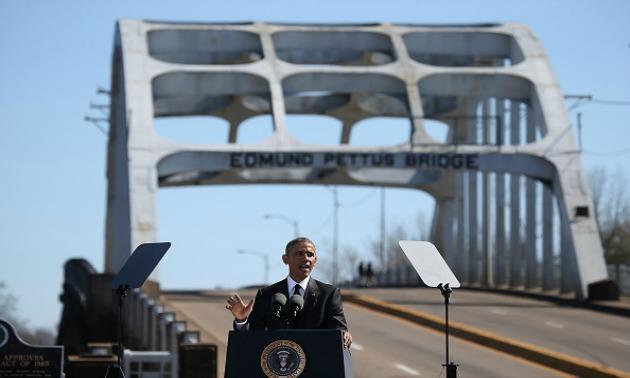
The march, a shooting and a song summed up this past weekend showing just how far this nation has gone and just how far it has yet to go.
The nation’s first African American president stood near the Edmund Pettus Bridge in Selma to mark the 50th anniversary of “Bloody Sunday,” one of the most important feats of the Civil Rights Movement. Out of the epic confrontation between forces of peace and progress and the agents of brute force, Blacks won the right to vote in the South.
“We just need to open our eyes and our ears and our hearts to know that this nation’s racial history still cast its long shadow upon us,” President Barack Obama told the integrated crowd of thousands who had gathered to commemorate, along with him, the Selma to Montgomery March. “We know the march is not yet over. We know the race is not yet won.”
As if to underscore the president’s point, some 898 miles north from Selma, in Madison, Wisconsin, another white cop shot and killed another unarmed black teenager and some 783 miles northwest of Selma, in Norman, Oklahoma, a YouTube video went viral exposing tuxedo-clad white frat boys from University of Oklahoma (OU)chanting a bus-trip song about racial exclusion and lynching.
The lyrics to the song were not exactly surprising, considering that Sigma Alpha Epsilon (SAE) is 159 years old and is the only national fraternity founded in the Antebellum South. The fraternity boasts on its website that during the Civil War 92 percent of SAE members fought for the Confederate states.
In case you missed the video or didn’t catch the lyrics, here they are in all of their good ol’ boy, old-fashioned, garden-variety racist glory:“There will never be a ni**** in SAE.There will never be a ni**** in SAE.You can hang him from a tree, but he can never sign with meThere will never be a ni**** in SAE.”
I find this alarming because this isn’t a bunch of curmudgeonly, bitter, old white men hating on hope and change, but instead young guys who are white America’s future. After these frat boys graduate from college, they’ll move on into the corporate pipeline where some day some of them will have the power to hire and fire with “there will never be a ni**** “ playing like the soundtrack to their lives in their heads.
The SAE chanters may represent a throwback to mid-century American racism, but times have changed. Rather than stonewall the Unheard, a group of Black student activists at OU who had learned of the video and posted it online, or buy time with a three-month investigation, David Boren, the university president, immediately shut the fraternity down.
The national headquarters of SAE, which prides itself on having a membership of “gentlemen and leaders.” followed Boren’s lead and immediately suspended the OU chapter.
With no blood thirsty state troopers or Selma police waiting to do battle, what was supposed to be a march was so well attended by so many movers and shakers that it turned into an extravaganza. Not only was America’s current president there but also former President George W. Bush, along with Capitol Hill lawmakers galore.
It was plainly easier to take photo-ops than it has been to pass a new voter’s rights law that would repair the damage the five right wing activists on the Supreme Court did two years ago to the 1965 Voting Rights Act. By a 5-4 vote, the Supreme Court ruled that southern states that had historically suppressed the Black vote no longer had to prove they were no longer suppressing the Black vote. Since then, southern states like Texas have come up with all sorts of creative, new-fangled ways to diminish the number of Blacks and Browns casting their votes at the ballot box.
We can vote now, but we can’t stop the unjustifiable killings of Black men and boys by frightened or ferocious cops.
Even with the “Black Lives Matter” and “Hands Up, Don’t Shoot” protests becoming this generation’s civil rights movement, policemen across the nation continue to create more martyrs.
Last Friday night, a Madison policeman shot Tony Robinson, an unarmed biracial teen, five times in the chest. The 19-year-old Robinson had a conviction last year for armed robbery and a diagnosis that he suffered from attention-deficit disorder and anxiety and depression.
Officer Matt Kenny, a 12-year veteran, has been put on paid administrative leave while the Wisconsin Department of Justice investigates Robinson’s death. Kenny was involved in another fatal shooting in 2007 that was found justified — a so-called suicide by cop case.
So while Selma was throwing a grand party, 2,000 protesters, mainly Wisconsin students, have been peacefully marching in Madison while chanting, “Black lives matter.”
Some students’ chants are far better than others.